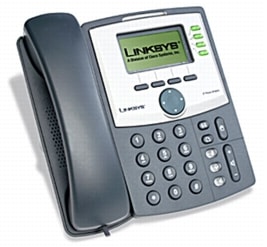Advanced, Affordable, Feature-Rich IP Phone for the Home Office and Business
Highlights
• Full-featured four-line business-class IP phone with display
• Connects directly to an Internet telephone service provider or to an IP PBX
• Speakerphone, caller ID, call hold, transfer, conferencing, and more
• Easy installation with secure remote provisioning, as well as menu-based and web-based configuration
Comprehensive Interoperability and SIP-Based Feature Set
Carrier-Grade Security, Provisioning, and Management
Figure 1. Cisco SPA941 4-Line IP Phone with 1-Port Ethernet

Telephony Features
• Four voice lines and up to eight call appearances
• Pixel-based display: 128 x 64 monochrome graphical liquid crystal display (LCD)
• Line status: active line indication, name and number
• Menu-driven user interface
• Shared line appearance**
• Speakerphone
• Call hold
• Music on hold**
• Call waiting
• Caller ID name and number
• Outbound caller ID blocking
• Call transfer: attended and blind
• Three-way call conferencing with local mixing
• Multiparty conferencing via external conference bridge**
• Automatic redial of last calling and last called numbers
• On-hook dialing
• Call pickup: selective and group**
• Call park and unpark**
• Call swap
• Call back on busy
• Call blocking: anonymous and selective
• Call forwarding: unconditional, no answer, on busy
• Hot line and warm line automatic calling
• Call logs (60 entries each): made, answered, and missed calls
• Redial from call logs
• Personal directory with auto-dial (100 entries)
• Do not disturb (callers hear line busy tone)
• Digits dialed with number auto-completion
• Uniform Resource Identifier (URI) (IP) dialing support (vanity numbers)
• On-hook default audio configuration (speakerphone and headset)
• Multiple ring tones with selectable ring tone per line
• Ability to call number using name: directory matching or via caller ID
• Subsequent incoming calls with calling name and number
• Date and time with intelligent daylight savings support
• Call duration and start time stored in call logs
• Call timer
• Name and identity (text) displayed at startup
• Distinctive ringing based on calling and called number
• 10 user-downloadable ring tones
• Speed dialing, eight entries
• Configurable dial/numbering plan support
• Intercom**
• Group paging**
• Network Address Translation (NAT) Traversal, including STUN support
• DNS SRV and multiple A records for proxy lookup and proxy redundancy
• Syslog, debug, report generation, and event logging
• Secure call encrypted voice communication support
• Built-in web server for administration and configuration with multiple security levels
• Automated remote provisioning, multiple methods; up to 256-bit encryption: (HTTP, HTTPS, Trivial File Transfer Protocol [TFTP])
• Option to require administrator password to reset unit to factory defaults
Hardware Features
• Pixel-based display: 128 x 64 monochrome graphical LCD
• Dedicated illuminated buttons for:
– Audio mute on/off
– Headset on/off
– Speakerphone on/off
• Four soft-key buttons
• Four-way rocking directional knob for menu navigation
• Voicemail message waiting indicator light
• Voicemail message retrieval button
• Dedicated hold button
• Settings button for access to feature, setup, and configuration menus
• Volume control rocking up/down knob to control handset, headset, speaker, and ringer
• Standard 12-button dialing pad
• High-quality handset and cradle
• Built-in high-quality microphone and speaker
• Headset jack: 2.5 mm
• Ethernet LAN: 10BASE-T RJ-45
• 5 VDC universal (100-240V) switching power adapter
• LED test function
Regulatory Compliance
• FCC (Part 15, Class B) , CE Mark, A-Tick
Security Features
• Password-protected system, preset to factory default
• Password-protected access to administrator and user-level features
• HTTPS with factory-installed client certificate
• HTTP digest: encrypted authentication via MD5 (RFC 1321)
• Up to 256-bit Advanced Encryption Standard (AES) encryption
Documentation
• Quick-start installation and configuration guide
• User guide
• Administration guide
• Provisioning guide (for service providers only)
Package Contents
• Cisco SPA941 IP Phone, handset, and stand
• Handset cord
• 5V power adapter
• RJ-45 Ethernet cable
• Quick-start installation and configuration guide
Specifications
Table 1. Specifications for the Cisco SPA941 4-Line IP Phone with 1-Port Ethernet
Table 2. Cisco Small Business IP Phone Comparison Chart
| Model | Voice Lines | Ethernet Ports | High-Resolution Graphical Display | PoE Support |
| SPA901 | 1 | 1 | No | No |
| SPA921 | 1 | 1 | Yes | No |
| SPA922 | 1 | 2 | Yes | Yes |
| SPA941 | 4 | 1 | Yes | No |
| SPA942 | 4 | 2 | Yes | Yes |
| SPA962 | 6 | 2 | Color | Yes |
Subject to customer authorization by Linksys.
Stylish and functional in design, the SPA941 VoIP Phone is ideal for a residence or business using a hosted IP telephony service, an IP PBX, or a large scale IP Centrex deployment. The SPA941 leverages industry leading VoIP technology from Linksys to deliver an upgradeable high quality IP Phone that is unparalleled in features, value, and support. Standard features on the SPA941 include two active lines, a high resolution graphical display, speakerphone, and a 2.5 mm head-set port. With a simple software update, the SPA941 is upgradeable to a four line phone. Each line can be independently configured to use a unique phone number (or extension), or can be configured to use a shared number that is assigned to multiple phones.